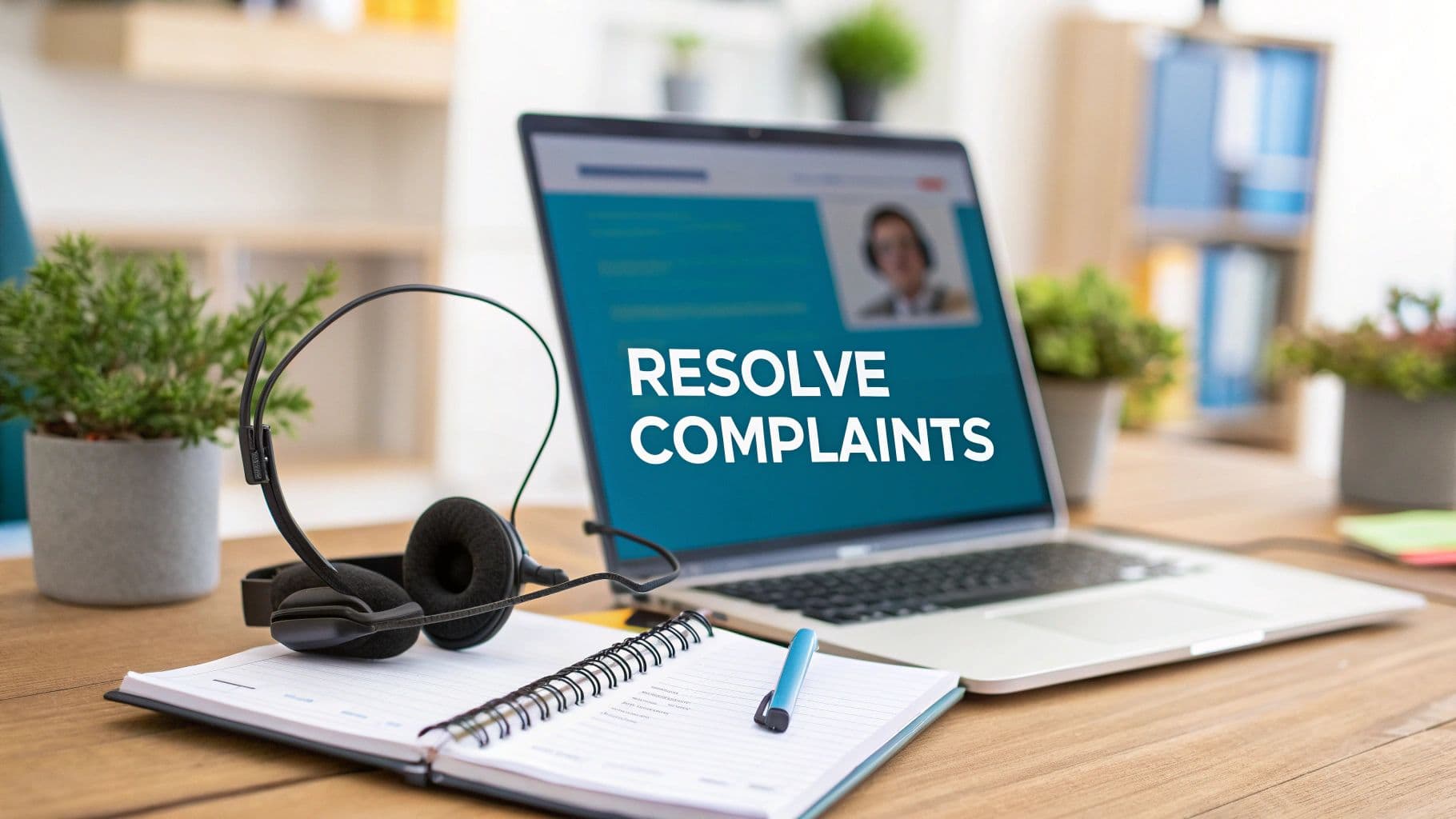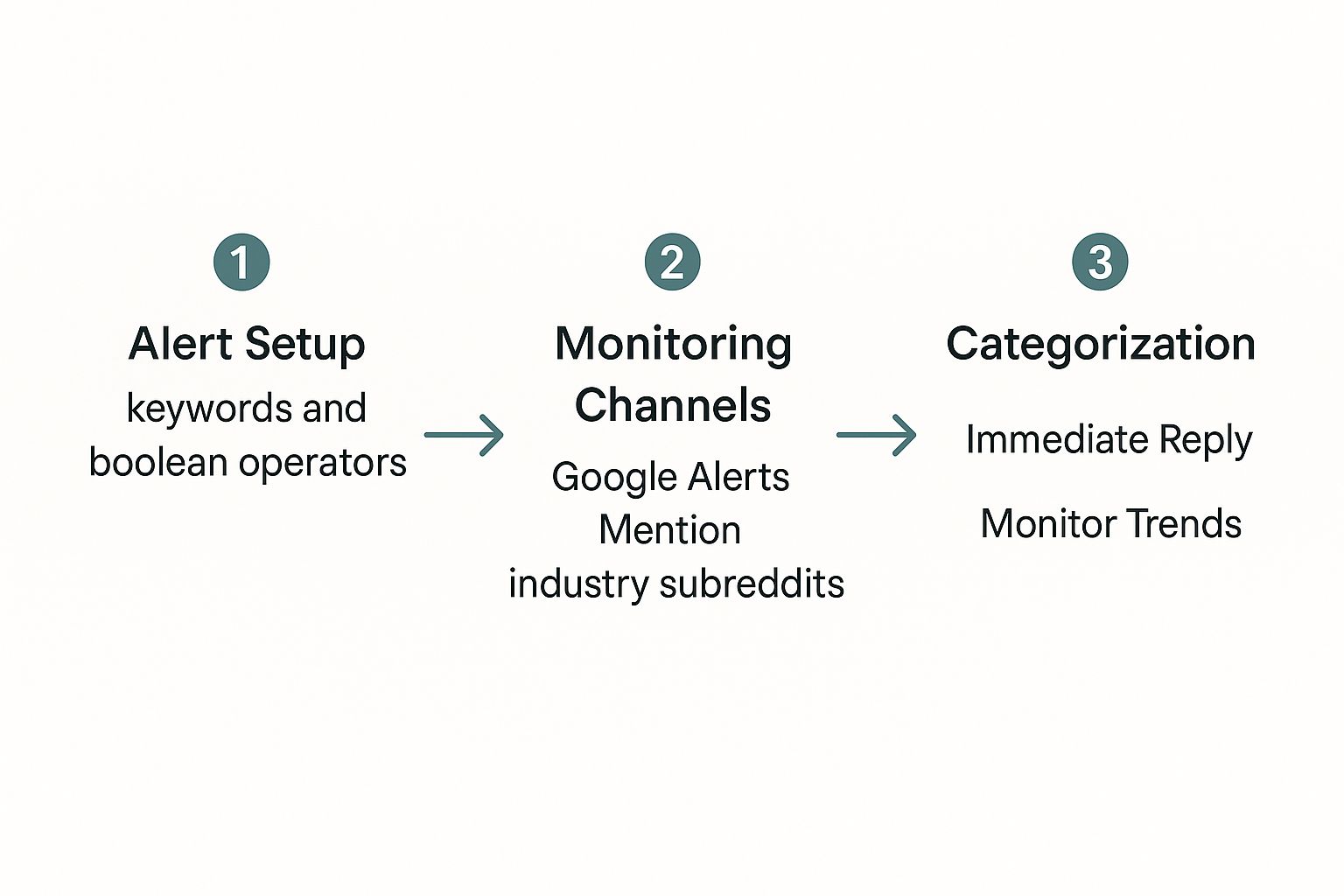
The only way to respond to a customer complaint is to ditch the corporate script and get personal. Acknowledge their frustration, own the problem without excuses, and empower your team to offer a real solution on the spot. This is how we turn a potentially disastrous interaction into a moment that builds fierce, lasting loyalty.
Why Generic Complaint Advice Fails Founders

Forget the robotic templates. As founders, we're handed a sterile playbook for dealing with unhappy customers, but that advice almost always creates more distance than connection. It’s designed to minimize liability, not build relationships.
At BillyBuzz, we learned this the hard way.
Early on, we completely botched a complaint. A simple billing error on our end locked a long-time user's account right before their big campaign launch. We fell back on "standard procedure"—a templated email apologizing for the "inconvenience." The response was clinical, detached, and totally missed the sheer panic our customer was experiencing.
That painful lesson taught us a critical truth: empathy isn't a buzzword; it's our most powerful tool. Founders can connect on a human level that big corporations can only dream of. Your customers chose you, not some faceless entity. Responding like one feels like a betrayal.
The Real Cost of a Bad Response
Getting this wrong carries a high price. It's not just about losing one customer; it’s the ripple effect. Research shows that 73% of consumers will jump to a competitor after just a few bad interactions. This statistic is a stark reminder of how poor complaint handling directly guts your retention and revenue.
This is why we threw out the old rulebook and built our response philosophy from the ground up. It’s less about a script and more about a mindset.
As a founder, every complaint is a conversation you can't afford to delegate or automate with a soulless template. It’s a moment to reinforce why your customer chose you—because there’s a real person who cares on the other side.
While most generic advice falls short, it's still crucial to understand the fundamentals behind proven strategies for handling customer complaints in any business. We've taken those core ideas and adapted them to fit our founder-led approach, always prioritizing authenticity over rigid protocol.
Before we jump into our specific tactics, let's look at the foundational principles that guide every single interaction our team has with a customer.
Our Core Principles for Complaint Response
This table summarizes the fundamental beliefs our team follows for every customer complaint, ensuring we are always consistent, effective, and human.
| Principle | Why It Matters | Actionable Tip |
|---|---|---|
| Lead with Empathy | It validates the customer's frustration and shows you're on their side, which immediately de-escalates the tension. | Start your reply by naming their feeling: "I can see how frustrating that would be" works miles better than "We apologize for the inconvenience." |
| Own the Problem | Taking responsibility, even if the issue wasn't directly your fault, builds immense trust and shows you're committed to a solution. | Avoid the blame game. Use "we" and "I" to show personal accountability for getting it resolved, no matter what. |
| Resolve and Follow Up | A quick fix is good. A lasting solution combined with a follow-up message shows you genuinely care about their long-term success with your product. | After you've solved the issue, circle back a few days later to make sure everything is still running smoothly. This small step has a massive impact. |
These principles aren't just rules on a wall; they are the bedrock of our customer relationships.
Our System for Finding Complaints Before They Escalate
You can't solve problems you don't know exist. The most dangerous customer complaints are the ones whispered on forums or posted on social media—the ones you never hear about directly.
That’s why at BillyBuzz, our strategy for handling complaints begins with a proactive, almost obsessive, monitoring system. We don't just wait for support tickets to land in our inbox. We actively hunt for dissatisfaction out in the wild.
This isn’t about vanity searches. It’s a defensive system designed to find and defuse issues before they spiral.
The public square of social media is where brands are built and broken. When companies engage with complaints on social media, customer advocacy can jump by as much as 25%. Ignoring them can slash advocacy by a brutal 50%, a reality detailed in this deep dive into customer service statistics.
Setting Up Our Digital Tripwires
Our first line of defense is a network of carefully crafted alerts. We use Google Alerts for broad web coverage and Mention for real-time social and forum tracking. The magic isn't in the tools, but in how precisely we configure our alert rules.
A generic alert for "BillyBuzz" is useless—it’s just noise. We use boolean operators to zero in on mentions that signal a problem. This filters out positive reviews and simple questions, so we can focus on what needs our immediate attention.
Here are our actual alert strings:
- For technical issues:
("BillyBuzz" OR billybuzz.com) AND ("not working" OR "broken" OR "bug" OR "error" OR "can't log in") - For billing problems:
"BillyBuzz" AND ("billing issue" OR "charged me" OR "refund" OR "credit card" OR "invoice") - For competitor comparisons:
("BillyBuzz" OR "BillyBuzz alternative") AND ("frustrated" OR "switched from" OR "disappointed") -site:billybuzz.com
That -site:billybuzz.com operator is crucial. It filters out mentions on our own website, so we’re only seeing external conversations. If you want to build a similar system, we put together a complete guide on setting up real-time social media alerts that walks through our entire process.
Monitoring the Unofficial Town Halls
Beyond broad alerts, we get specific about where our customers congregate online. For a SaaS company like ours, Reddit is a goldmine of unfiltered feedback. Manually checking subreddits all day is a massive time sink, so we automate it.
We keep a dedicated, evolving list of subreddits that our system monitors constantly. This includes:
- Broad Industry Hubs: Like
r/SaaS,r/marketing, andr/smallbusiness. - Niche Communities: Subreddits focused on topics like
r/SEO,r/leadgeneration, orr/communitymanager. - Competitor Hangouts: We even monitor competitors' dedicated subreddits (
r/CompetitorTool) to understand their user frustrations and spot opportunities.
Our tool flags any mention of our brand or common industry pain points within these communities. This gives us an incredible ear to the ground, allowing us to jump into conversations organically.
The infographic below gives you a glimpse of our process, from setting up the alerts to categorizing incoming mentions so we can respond fast.

This workflow ensures we're not just reacting, but actively listening and prioritizing the conversations that matter most.
Categorizing Mentions for a Rapid Response
Once an alert comes in, the final step is triage. Not every negative mention is a five-alarm fire. Flooding our support team with every grumble leads to burnout and slow response times for critical issues.
To avoid that, we categorize every alert that comes through our system.
Every complaint is a data point. A single user struggling might be an anomaly. Five users struggling with the same thing? That’s the beginning of a trend that needs product-level attention.
Our categorization system is simple but effective:
- Immediate Reply Needed: Public complaints on Twitter or Reddit, any mention from an influential user, or anything related to billing or account access. These are all-hands-on-deck issues requiring a response within the hour.
- Monitor for Trends: Vague feedback, feature requests disguised as complaints, or comments where the user isn't looking for a direct solution. We track these to identify recurring themes that inform our product roadmap.
This structured approach transforms a chaotic stream of notifications into an actionable intelligence system. It ensures we spend our energy on the fires that matter most, turning potential PR crises into opportunities to show our commitment.
Our Internal Response Protocol: The ACE Framework

The moment our system flags a complaint, we don’t wing it. We use a simple but effective internal protocol called the ACE Framework.
It’s a three-part mental model that guides every interaction: Acknowledge, Clarify, and Empower. This framework is the backbone of how we respond, ensuring we de-escalate tension and move toward a genuine solution—fast.
Acknowledge the Customer’s Frustration
First, validate their feelings. This is where most companies fail, jumping straight to a solution or getting defensive. Acknowledging their emotion shows you’re listening and that you're on their side.
This isn't about admitting fault; it's about recognizing their emotional state. A CMO Council study found that the #1 most important attribute of good customer experience is a fast response time, and a huge part of that is emotional validation.
Here are phrases from our internal playbook:
- "I can definitely see how frustrating it would be to have your dashboard freeze right before a presentation."
- "That’s completely understandable. It’s not okay that you were billed incorrectly, and I'm on it."
- "You’re right to be upset. The feature isn’t working as it should, and I'm sorry for the trouble."
These phrases connect on a human level. They lower a customer's guard and make them more receptive to finding a fix with you.
Clarify the Root of the Problem
Once you've acknowledged their frustration, it's time to become a friendly detective. Customers often describe the symptom, not the cause.
Ask smart, open-ended questions to gather the full story. Avoid peppering them with "yes" or "no" questions.
Our go-to clarifying questions:
- "Could you walk me through the exact steps you took before the error popped up?"
- "To make sure I'm on the same page, what was the outcome you were expecting to see here?"
- "What have you already tried? That will help me avoid suggesting things you've already done."
Getting clarity prevents you from offering a solution that misses the mark. This step ensures the fix actually solves their specific issue. To get your team ready, it helps to review common customer complaints and their effective handling strategies to anticipate problems.
Empower Your Team to Offer a Real Solution
This is the most critical part. Acknowledging and clarifying mean nothing if you can't solve the problem. At BillyBuzz, we empower our frontline team to offer solutions on the spot, without navigating layers of red tape.
We trust our team to make the right call. A support agent who has to say "I need to ask my manager" is a support agent who has been stripped of their power to help. That’s a cardinal sin in our playbook.
What empowerment looks like in practice here:
- Immediate Refunds: If it's a billing error, our team can process a refund or account credit right then and there.
- Account Upgrades: For a serious service disruption, they can offer a complimentary upgrade for a month.
- Direct Escalation: They can directly flag bugs for our engineering team with "high priority" status.
How you frame the solution is just as important. Instead of a sterile "We will fix it," we say, "Here's what I'm going to do for you right now." This simple shift makes the customer feel genuinely cared for. Our guide on integrating moderation tools with existing systems offers more insight into how we build the workflows that give our team this autonomy.
Real-World Response Templates We Use Every Day
Theory is one thing; the exact words you use are everything. Here are the copy-and-paste-ready responses we use ourselves at BillyBuzz.
But first, why is this so critical? The biggest challenge isn't the complaints you get; it's the ones you don't. Research from ProProfs Chat shows that a staggering 91% of unhappy customers just leave without a word. That silent churn is a business killer.
The good news? Up to 67% of that churn can be prevented if you handle complaints correctly. Every complaint is a gift—a chance to save a customer and fix a problem affecting others who are staying quiet. Our templates are built to make the most of that opportunity.
Handling Public Complaints on Twitter
When someone calls you out on Twitter, you’re on the clock. Speed and a pitch-perfect tone are non-negotiable. Acknowledge the problem publicly, then immediately pull the conversation into a private channel.
Scenario: A user tweets, "@BillyBuzz your Reddit monitoring just sent me 3 alerts for the same keyword. Your system is broken and spamming my inbox. Not cool."
Our Template:
"Hey [User Handle], thanks for flagging this. That’s definitely not the experience we want for you, and I can see how frustrating a flooded inbox would be. I’m looking into our alert system right now. Could you DM me the email address associated with your account so I can investigate your specific alerts?"
Why it works:
- Acknowledge & Validate: We lead with "That’s definitely not the experience we want" and "I can see how frustrating..."
- Take Ownership: "I’m looking into our alert system right now" shows we're already on it.
- Move to Private: The final sentence takes sensitive details and troubleshooting offline.
Responding to a Detailed Bug Report via Email
Email complaints are often more detailed. They come from users invested enough to write a full report. Your response has to match that effort.
Scenario: A user sends a multi-paragraph email to support, with screenshots, showing how our AI relevancy scoring is miscategorizing posts.
Our Template:
"Hi [Customer Name],
Wow, thank you so much for this incredibly detailed breakdown and for taking the time to include screenshots. This is exactly the kind of feedback that helps us make BillyBuzz better.
You’re right—based on your examples, the relevancy score isn't behaving as it should for those specific subreddits. I’ve already created a high-priority ticket (TICKET-ID-12345) and escalated it directly to our engineering team with all the information you provided.
I'll personally follow up with you as soon as I have an update from the team. We truly appreciate you helping us spot this."
Why it works:
- Show Genuine Gratitude: "Wow, thank you..." feels personal and positions them as a helpful partner.
- Provide Proof of Action: Sharing the ticket ID and mentioning the escalation proves you’ve done more than fire off a canned reply.
- Promise Personal Follow-up: "I'll personally follow up" provides a single point of contact and shows accountability.
Addressing Negative Feedback on G2 or Capterra
Review sites like G2 and Capterra are high-stakes. Your response has two audiences: the reviewer and every potential customer who reads it.
Scenario: A user leaves a 2-star review on G2 titled "Great concept, but buggy and unreliable," detailing chronic issues with alert delivery.
Our Template:
"Hi [Reviewer Name], thank you for sharing your honest feedback. I’m truly sorry to hear that your experience with our alert reliability hasn’t met your expectations—or ours. That's a core part of our service, and it's clear we've let you down.
We have been working on improving our alert delivery infrastructure, but feedback like yours shows us we still have work to do. I’d love the chance to connect directly to understand the specifics of your account and see if we can make this right for you. Please feel free to book a time with me directly here: [Link to your Calendly]."
Why it works:
- Own the Shortcoming: "It's clear we've let you down" is a powerful, disarming statement of ownership.
- Provide Context (Not Excuses): Mentioning improvements shows you’re proactive without invalidating their experience.
- Offer a Direct Line: Dropping a Calendly link is a bold move that shows you're not hiding.
To make this even easier, here's a quick-reference table that maps common complaint types to the best initial response strategy. It's a cheat sheet we use internally to make sure our first move is always the right one.
Complaint Scenario vs Response Tactic
| Complaint Type | Channel | Primary Goal | Key Tactic |
|---|---|---|---|
| Technical Bug | Acknowledge & Gather Info | Express gratitude for the detail, confirm receipt, and provide a ticket number. | |
| Public Call-Out | Social Media | De-escalate & Move Private | Validate their frustration publicly, state you're investigating, and ask to switch to DMs. |
| Billing Error | Phone / Chat | Reassure & Resolve Fast | Apologize for the error, confirm you're correcting it immediately, and state the exact fix. |
| Negative Review | G2 / Capterra | Show Accountability | Thank them for the feedback, own the failure publicly, and offer a direct line to solve it. |
Remember, the goal isn't just to close a ticket but to show the customer—and anyone else watching—that you genuinely care.
These aren't just templates; they're frameworks for real conversations. Always tweak the wording to match the specific tone and context of the complaint. The goal is human connection, not robotic automation.
Turning Feedback into Your Greatest Growth Asset

Successfully resolving a single complaint is table stakes. The real magic is using that raw, honest feedback to make your product fundamentally better.
At BillyBuzz, we don’t treat customer support like a cost center. We see it as our most valuable R&D department. Every complaint is a data point showing us where our product falls short. Ignoring this would be like ignoring a focus group you didn't pay for.
We've built a simple but powerful internal feedback loop to turn individual complaints into collective product intelligence.
Our System for Tagging and Tracking Feedback
It starts the moment a complaint comes in. Our team doesn't just resolve the issue—they categorize it. Inside our CRM, every interaction gets tagged with keywords that pinpoint the problem.
We keep our tagging system straightforward, building it around product areas and pain points. Our most common tags look like this:
bug-alert-deliveryux-dashboard-confusingbilling-invoice-errorfeature-request-sentiment-analysis
This simple habit creates a structured, searchable database of customer pain. We can instantly pull up every complaint related to a specific feature. It’s our ground-truth data source for what needs fixing most urgently.
From CRM to a Simple Tracking Spreadsheet
To see the forest for the trees, our support lead updates a simple Google Sheet at the end of each week.
The sheet only has four columns:
- Complaint Theme: A consolidation of our CRM tags (e.g., "Alert Delivery Delays").
- Number of Mentions: A count of unique customers who reported this issue this week.
- Customer Impact Score (1-5): A gut-check score on how much this issue is hurting the user experience. A billing error is a 5; a minor UI typo is a 1.
- Notes/Example Tickets: Links to a few representative CRM tickets so the product team can see the raw feedback.
This spreadsheet gives us a high-level view of what’s causing the most friction. If we see bug-alert-delivery spike from 2 mentions one week to 15 the next, we know we have a serious problem.
We don’t just fix problems; we analyze them. Every complaint is a breadcrumb that, when followed, leads directly to a product improvement. This mindset is what turns your support team into a growth engine.
How Complaint Data Fuels Our Product Meetings
This spreadsheet is the centerpiece of our weekly product development meetings. Every Tuesday morning, our support lead presents the top three to five complaint themes from the previous week. It's the very first item on our agenda.
This process ensures the voice of the customer is baked directly into our development cycle. The data from our complaint tracker directly influences our sprint planning and product roadmap.
For example, a few months ago, we saw a steady increase in tickets tagged ux-keyword-setup. Customers found our interface for adding keywords confusing. Based on that data, we prioritized a redesign of the keyword setup flow. The result? A 40% reduction in support tickets related to that feature and a flood of positive feedback. That's a direct line from customer complaint to product improvement to better retention. This structured approach is critical. You can learn more about how AI improves customer feedback integration in our detailed guide on the topic.
Frequently Asked Questions
Even with the best game plan, you'll run into tricky situations. We’ve been there at BillyBuzz and have fielded these same questions from other founders. Here are our straight-to-the-point answers.
What’s the Quickest Way to De-escalate an Angry Customer?
Immediately validate their feelings. Don't jump into problem-solving. Acknowledge their frustration first.
A simple, “I can completely see why you’re so upset—that’s not the experience we want for anyone,” works wonders. It instantly lowers their guard because it shows you're on their side. Most anger stems from feeling ignored, so proving you're listening is half the battle.
Should I Apologize Even If It Wasn't Our Fault?
Yes, but apologize for the customer's bad experience, not for something you didn't do. This is different from a hollow, "we apologize for any inconvenience."
Try something genuine:
"I'm genuinely sorry for how frustrating this has been for you. I can tell this has been a real headache, and I want to help you get it sorted out."
This phrasing takes ownership of their frustration without wrongly admitting fault. It builds a bridge by showing you care, shifting the focus from blame to a solution.
How Do I Respond to a Vague Complaint Like 'Your Product Sucks'?
It’s easy to get defensive, but these complaints are often a cry for help. Your job is to turn that raw emotion into something actionable. Don't argue—get curious.
Acknowledge their feeling, then gently ask for more information. At BillyBuzz, a go-to response is:
"I'm really sorry to hear you're having such a bad experience. That's definitely not what we're aiming for. To help me figure out what's going on, could you tell me a little more about what you were trying to do when you ran into trouble?"
This approach accomplishes three things:
- It validates: You're on their side.
- It asks for context: You move from emotion to a specific task.
- It offers help: You show you're ready to solve a problem.
This pivot can transform a destructive comment into a constructive conversation, often uncovering an issue you might have otherwise missed.
Ready to stop missing critical conversations on Reddit? BillyBuzz uses AI to find relevant customer complaints and sales opportunities in real-time, so you can engage at the perfect moment. Discover hidden leads and manage your brand reputation today.
